-
 Bitcoin
Bitcoin $107,631.9817
-1.73% -
 Ethereum
Ethereum $2,739.1787
-4.61% -
 Tether USDt
Tether USDt $1.0000
-0.01% -
 XRP
XRP $2.2427
-3.30% -
 BNB
BNB $664.0527
-0.73% -
 Solana
Solana $158.0902
-5.38% -
 USDC
USDC $0.9998
-0.01% -
 Dogecoin
Dogecoin $0.1876
-7.78% -
 TRON
TRON $0.2753
-3.21% -
 Cardano
Cardano $0.6820
-5.55% -
 Hyperliquid
Hyperliquid $43.0171
-0.38% -
 Sui
Sui $3.3308
-4.87% -
 Chainlink
Chainlink $14.3431
-7.89% -
 Avalanche
Avalanche $21.0266
-6.48% -
 Bitcoin Cash
Bitcoin Cash $437.7657
-1.56% -
 Stellar
Stellar $0.2746
-2.52% -
 UNUS SED LEO
UNUS SED LEO $8.8665
-1.96% -
 Toncoin
Toncoin $3.1885
-3.37% -
 Shiba Inu
Shiba Inu $0.0...01260
-6.84% -
 Hedera
Hedera $0.1686
-4.93% -
 Litecoin
Litecoin $88.8406
-5.16% -
 Polkadot
Polkadot $4.0542
-6.28% -
 Monero
Monero $322.5806
-4.20% -
 Ethena USDe
Ethena USDe $1.0004
-0.02% -
 Bitget Token
Bitget Token $4.7089
-3.10% -
 Dai
Dai $0.9998
-0.01% -
 Pepe
Pepe $0.0...01206
-9.06% -
 Uniswap
Uniswap $7.8694
-5.20% -
 Pi
Pi $0.6232
-2.68% -
 Aave
Aave $301.3815
-3.83%
How deep is the retracement after breaking through the downward trend line? Is it a confirmation of validity or a failure of the breakthrough?
After breaking a downward trend line, a shallow retracement often confirms a valid breakout, while a deep one may signal failure, influencing trading strategies.
Jun 10, 2025 at 02:43 am
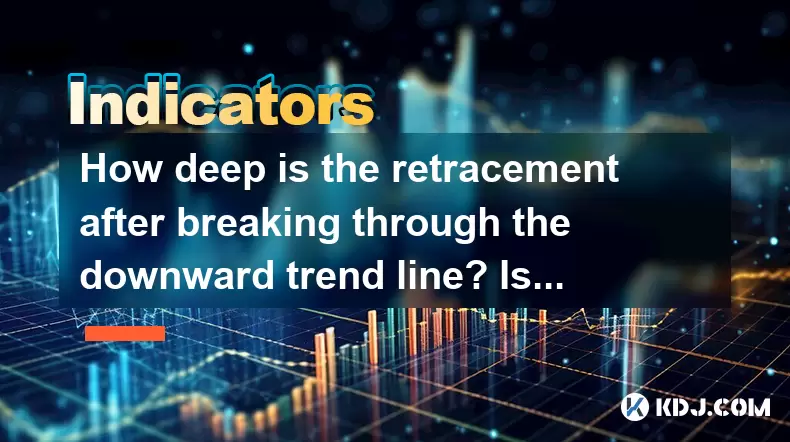
Understanding Retracement After Breaking Through a Downward Trend Line
When a cryptocurrency price breaks through a downward trend line, it often signals a potential shift in market sentiment from bearish to bullish. However, the immediate aftermath of such a breakout is crucial for traders and investors to assess its validity. One of the key indicators to watch is the depth of the retracement following the breakout. This article delves into the intricacies of retracement after breaking through a downward trend line, exploring whether it serves as a confirmation of the breakout's validity or a sign of its failure.
What is a Downward Trend Line Breakout?
A downward trend line is drawn by connecting a series of lower highs on a price chart, indicating a bearish trend. When the price breaks above this line, it suggests that the bearish momentum may be weakening, and a potential reversal to a bullish trend could be imminent. However, the breakout's validity is not immediately confirmed; it requires further price action to validate the move.
The Concept of Retracement
Retracement refers to a temporary reversal in the price direction following a significant move. After breaking through a downward trend line, it is common for the price to pull back towards the breakout point. The depth of this retracement is critical in assessing the strength of the breakout. A shallow retracement often indicates strong bullish momentum, while a deep retracement may suggest that the breakout was premature or lacked sufficient buying pressure.
Factors Influencing the Depth of Retracement
Several factors can influence the depth of retracement following a downward trend line breakout. These include:
- Market Sentiment: The overall sentiment in the cryptocurrency market can significantly impact the depth of retracement. If the market is generally bullish, the retracement might be shallow as buyers quickly step in to support the price.
- Volume: The trading volume during and after the breakout can provide clues about the strength of the move. Higher volume during the breakout and subsequent price action often indicates a more robust breakout, leading to a shallower retracement.
- Technical Indicators: Various technical indicators, such as the Relative Strength Index (RSI) and Moving Averages, can help traders gauge the potential depth of the retracement. For instance, an overbought RSI might suggest a deeper retracement is likely.
Analyzing Retracement as Confirmation or Failure
The depth of the retracement after breaking through a downward trend line can be interpreted in two ways: as a confirmation of the breakout's validity or as a sign of its failure.
- Confirmation of Validity: If the retracement is relatively shallow and the price quickly resumes its upward trajectory, it can be seen as a confirmation of the breakout's validity. This scenario suggests that the bullish momentum is strong enough to overcome temporary pullbacks, reinforcing the likelihood of a sustained upward trend.
- Failure of the Breakout: Conversely, if the retracement is deep and the price fails to regain the breakout level, it may indicate a failure of the breakout. In such cases, the initial breakout might have been a false signal, and the bearish trend could continue or resume.
Case Studies of Retracement After Downward Trend Line Breakouts
To illustrate these concepts, let's look at a couple of hypothetical case studies involving Bitcoin (BTC) and Ethereum (ETH).
Case Study 1: Bitcoin (BTC)
Imagine that Bitcoin breaks through a long-term downward trend line at $30,000. Following the breakout, the price retraces to $29,000, which represents a retracement of approximately 3.33%. After this shallow retracement, the price quickly rebounds and continues its upward move, reaching $32,000 within a few days. In this scenario, the shallow retracement serves as a confirmation of the breakout's validity, indicating strong bullish momentum.
Case Study 2: Ethereum (ETH)
In another scenario, Ethereum breaks through a downward trend line at $2,000. However, the price retraces deeply to $1,800, representing a retracement of 10%. The price struggles to regain the breakout level and eventually falls further, signaling a failure of the breakout. This deep retracement suggests that the bullish momentum was insufficient to sustain the upward move, and the bearish trend may continue.
Trading Strategies Based on Retracement Depth
Traders can develop strategies based on the depth of the retracement following a downward trend line breakout. Here are a few approaches:
- Shallow Retracement Strategy: If the retracement is shallow, traders might look to enter long positions near the breakout level, anticipating a continued upward move. Stop-loss orders can be placed just below the breakout level to manage risk.
- Deep Retracement Strategy: In the case of a deep retracement, traders might wait for the price to regain the breakout level before entering long positions. Alternatively, they might consider short positions if the price fails to reclaim the breakout level, indicating a potential continuation of the bearish trend.
- Using Technical Indicators: Traders can use technical indicators like the Fibonacci retracement tool to identify potential support levels during a retracement. For instance, if the price retraces to the 38.2% Fibonacci level and bounces back, it could signal a strong breakout.
Psychological Aspects of Retracement
The psychological aspect of retracement cannot be overlooked. After a breakout, traders and investors may experience a mix of emotions, including excitement, fear, and doubt. A shallow retracement can boost confidence in the breakout's validity, encouraging more buying. Conversely, a deep retracement can lead to fear and doubt, causing some traders to exit their positions prematurely, potentially exacerbating the downward move.
Conclusion on Retracement and Breakout Validity
The depth of the retracement after breaking through a downward trend line is a critical factor in assessing the breakout's validity. While a shallow retracement often confirms the breakout's strength, a deep retracement may indicate a failure. Traders must consider various factors, including market sentiment, volume, and technical indicators, to make informed decisions based on the retracement depth.
Frequently Asked Questions
Q1: How can traders differentiate between a healthy retracement and a sign of a failed breakout?
A1: Traders can differentiate between a healthy retracement and a failed breakout by observing the depth of the retracement and the subsequent price action. A healthy retracement is typically shallow and followed by a swift resumption of the upward trend. In contrast, a deep retracement that fails to regain the breakout level may indicate a failed breakout. Additionally, traders should monitor volume and technical indicators to gain further insights into the breakout's strength.
Q2: Are there specific technical indicators that can help predict the depth of a retracement?
A2: Yes, several technical indicators can help predict the depth of a retracement. The Fibonacci retracement tool is particularly useful, as it identifies potential support levels during a retracement. Other indicators, such as the Relative Strength Index (RSI) and Moving Averages, can also provide insights into the potential depth of a retracement by indicating overbought or oversold conditions and trend strength.
Q3: How should traders adjust their risk management strategies based on the depth of retracement?
A3: Traders should adjust their risk management strategies based on the depth of retracement. For a shallow retracement, traders might set stop-loss orders just below the breakout level to protect against a potential failure. In the case of a deep retracement, traders may need to widen their stop-loss levels or wait for the price to reclaim the breakout level before entering new positions. Additionally, position sizing should be adjusted to account for the increased risk associated with deeper retracements.
Q4: Can the depth of retracement vary across different cryptocurrencies?
A4: Yes, the depth of retracement can vary across different cryptocurrencies due to factors such as market liquidity, volatility, and investor sentiment. For instance, a highly liquid cryptocurrency like Bitcoin might experience shallower retracements compared to a less liquid altcoin, as there is more buying pressure to support the price. Traders should consider these factors when analyzing the depth of retracement for different cryptocurrencies.
Disclaimer:info@kdj.com
The information provided is not trading advice. kdj.com does not assume any responsibility for any investments made based on the information provided in this article. Cryptocurrencies are highly volatile and it is highly recommended that you invest with caution after thorough research!
If you believe that the content used on this website infringes your copyright, please contact us immediately (info@kdj.com) and we will delete it promptly.
- Expert Predicts When Bitcoin (BTC) Price Could Hit a New All-Time High
- 2025-06-13 02:00:20
- US President Donald Trump Virtually Spoke at the Coinbase State of Crypto Summit
- 2025-06-13 02:00:20
- Arctic Pablo Coin (APC) Explodes Onto the Meme Coin Stage as One of the Top New Meme Coins for Exponential Returns
- 2025-06-13 01:55:12
- Litecoin (LTC) Price Nosedives as Bollinger Bands Signal Lingering Bearish Sentiment
- 2025-06-13 01:55:12
- DeFi Development Corp. (DFDV) Secures $5 Billion Equity Line of Credit from RK Capital Management
- 2025-06-13 01:50:12
- Tether Expands Gold Strategy with Stake in Elemental Altus Royalties
- 2025-06-13 01:50:12
Related knowledge
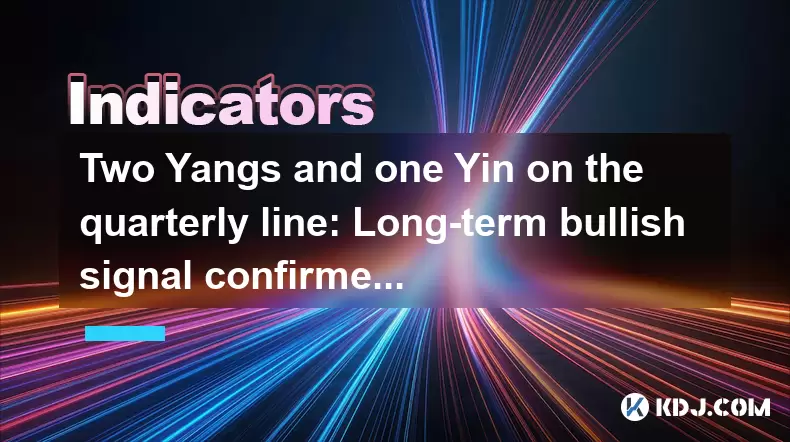
Two Yangs and one Yin on the quarterly line: Long-term bullish signal confirmed?
Jun 12,2025 at 07:00am
Understanding the 'Two Yangs and One Yin' Candlestick PatternIn technical analysis, candlestick patterns play a pivotal role in identifying potential market reversals or continuations. The 'Two Yangs and One Yin' pattern is one such formation that traders often observe on longer timeframes like the quarterly chart. This pattern consists of two bullish (...
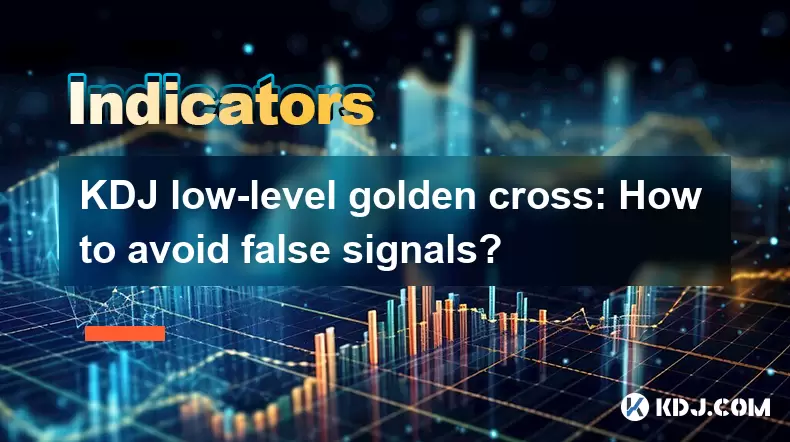
KDJ low-level golden cross: How to avoid false signals?
Jun 12,2025 at 08:21am
Understanding the KDJ IndicatorThe KDJ indicator, also known as the stochastic oscillator, is a momentum-based technical analysis tool widely used in cryptocurrency trading. It consists of three lines: the %K line (fast stochastic), the %D line (slow stochastic), and the %J line (divergence value). These lines oscillate between 0 and 100, helping trader...

Bottom-up volume stagnation: Is it accumulation or heavy selling pressure?
Jun 12,2025 at 01:42pm
What Is Bottom-Up Volume Stagnation?Bottom-up volume stagnation refers to a specific pattern observed in cryptocurrency trading charts where the price of an asset moves sideways or slightly downward, and trading volume remains consistently low over an extended period. This phenomenon is often seen after a sharp price drop or during a prolonged bear mark...
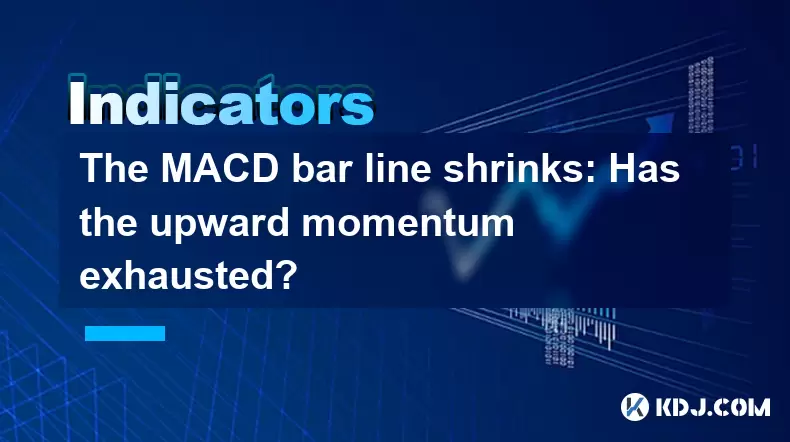
The MACD bar line shrinks: Has the upward momentum exhausted?
Jun 12,2025 at 12:49am
Understanding the MACD Bar LineThe Moving Average Convergence Divergence (MACD) is a widely used technical indicator in cryptocurrency trading. It consists of three main components: the MACD line, the signal line, and the MACD histogram (also known as the bar line). The MACD bar line represents the difference between the MACD line and the signal line. W...

The chip peak moves up: Is the main force quietly shipping?
Jun 12,2025 at 01:01am
Understanding the Chip Peak Movement in Cryptocurrency MiningIn recent years, the chip peak movement has become a critical topic within the cryptocurrency mining community. This phrase typically refers to the point at which mining hardware reaches its maximum efficiency and output capacity. When this peak shifts upward, it often signals changes in the s...
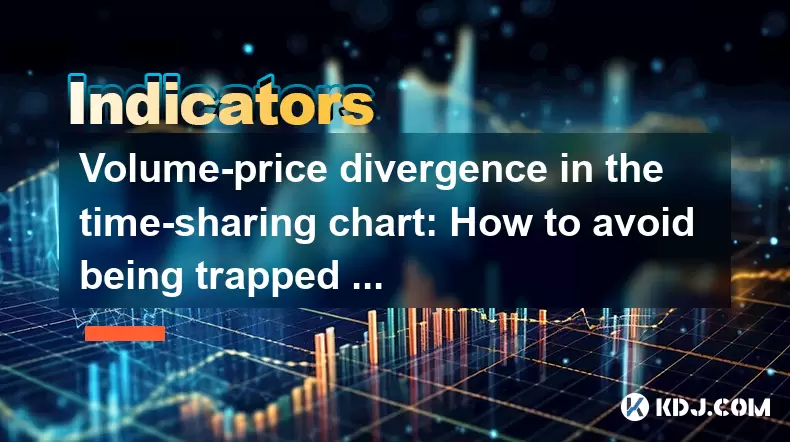
Volume-price divergence in the time-sharing chart: How to avoid being trapped on the same day?
Jun 12,2025 at 07:28pm
Understanding Volume-Price Divergence in Cryptocurrency TradingVolume-price divergence is a critical concept in technical analysis, especially within the fast-moving world of cryptocurrency trading. It refers to a situation where price movement and trading volume move in opposite directions. For instance, if the price of a cryptocurrency is rising while...

Two Yangs and one Yin on the quarterly line: Long-term bullish signal confirmed?
Jun 12,2025 at 07:00am
Understanding the 'Two Yangs and One Yin' Candlestick PatternIn technical analysis, candlestick patterns play a pivotal role in identifying potential market reversals or continuations. The 'Two Yangs and One Yin' pattern is one such formation that traders often observe on longer timeframes like the quarterly chart. This pattern consists of two bullish (...

KDJ low-level golden cross: How to avoid false signals?
Jun 12,2025 at 08:21am
Understanding the KDJ IndicatorThe KDJ indicator, also known as the stochastic oscillator, is a momentum-based technical analysis tool widely used in cryptocurrency trading. It consists of three lines: the %K line (fast stochastic), the %D line (slow stochastic), and the %J line (divergence value). These lines oscillate between 0 and 100, helping trader...

Bottom-up volume stagnation: Is it accumulation or heavy selling pressure?
Jun 12,2025 at 01:42pm
What Is Bottom-Up Volume Stagnation?Bottom-up volume stagnation refers to a specific pattern observed in cryptocurrency trading charts where the price of an asset moves sideways or slightly downward, and trading volume remains consistently low over an extended period. This phenomenon is often seen after a sharp price drop or during a prolonged bear mark...

The MACD bar line shrinks: Has the upward momentum exhausted?
Jun 12,2025 at 12:49am
Understanding the MACD Bar LineThe Moving Average Convergence Divergence (MACD) is a widely used technical indicator in cryptocurrency trading. It consists of three main components: the MACD line, the signal line, and the MACD histogram (also known as the bar line). The MACD bar line represents the difference between the MACD line and the signal line. W...

The chip peak moves up: Is the main force quietly shipping?
Jun 12,2025 at 01:01am
Understanding the Chip Peak Movement in Cryptocurrency MiningIn recent years, the chip peak movement has become a critical topic within the cryptocurrency mining community. This phrase typically refers to the point at which mining hardware reaches its maximum efficiency and output capacity. When this peak shifts upward, it often signals changes in the s...

Volume-price divergence in the time-sharing chart: How to avoid being trapped on the same day?
Jun 12,2025 at 07:28pm
Understanding Volume-Price Divergence in Cryptocurrency TradingVolume-price divergence is a critical concept in technical analysis, especially within the fast-moving world of cryptocurrency trading. It refers to a situation where price movement and trading volume move in opposite directions. For instance, if the price of a cryptocurrency is rising while...
See all articles

























































































